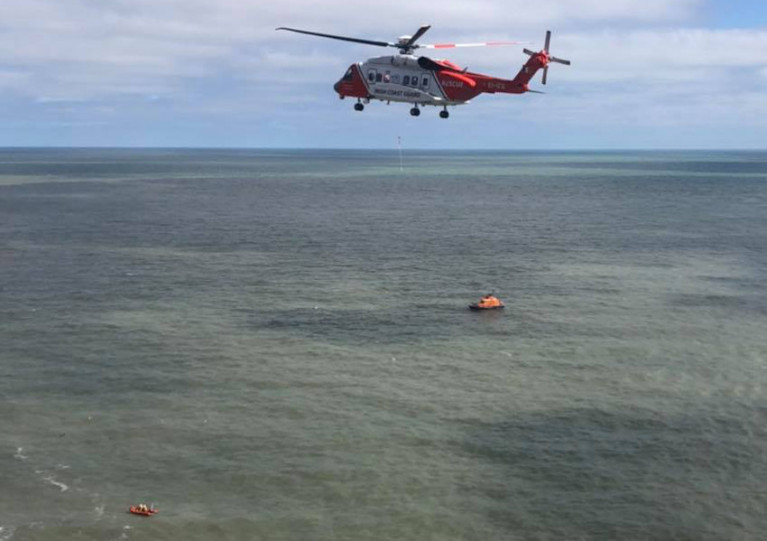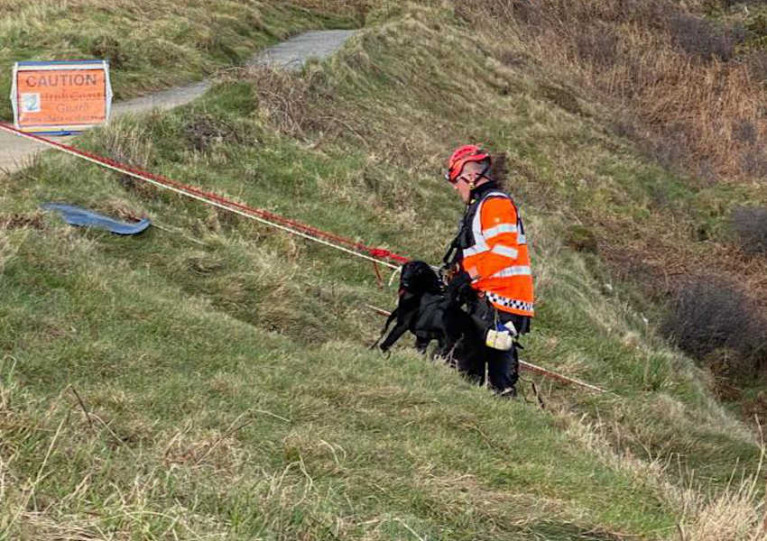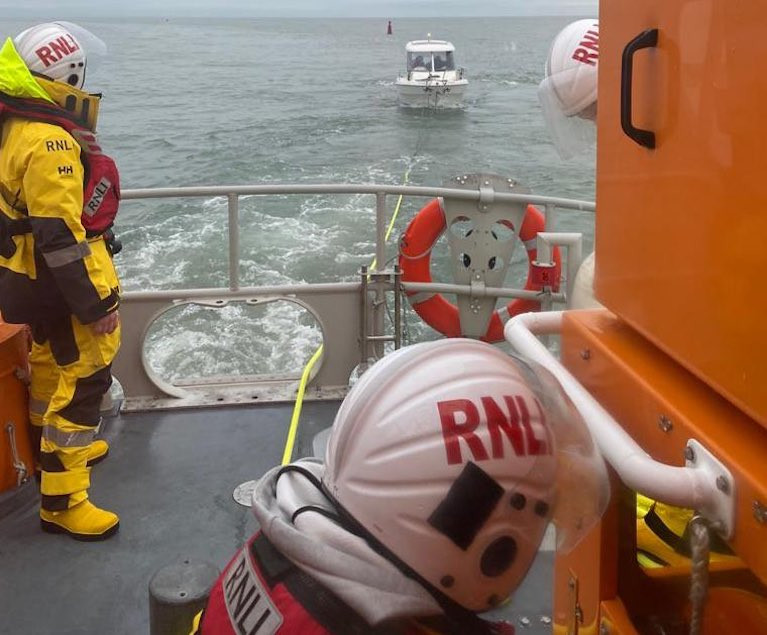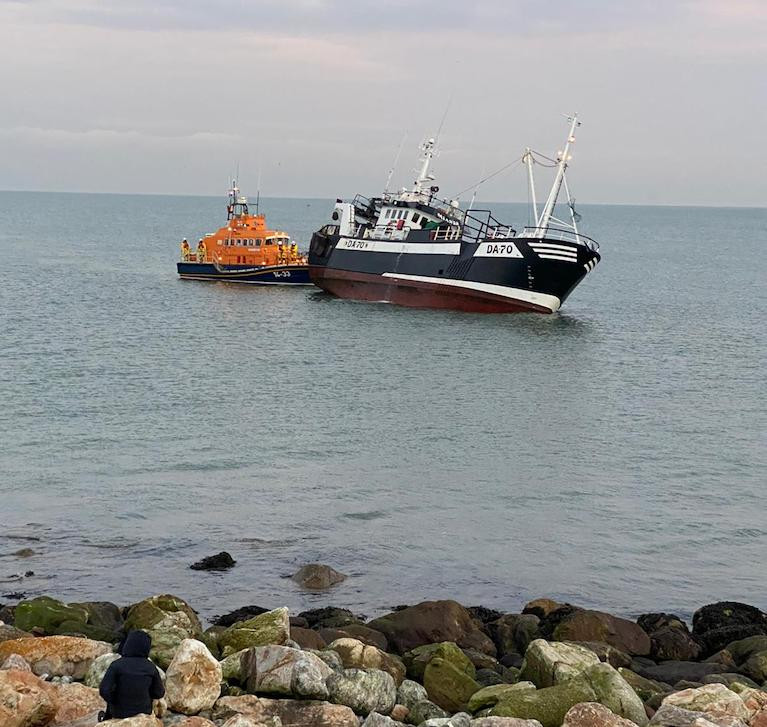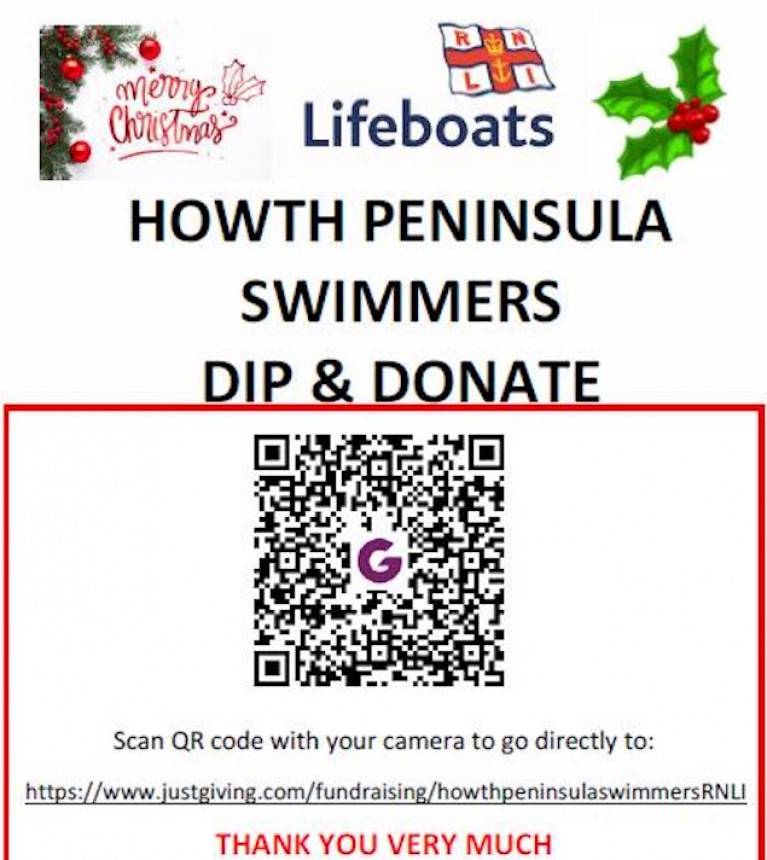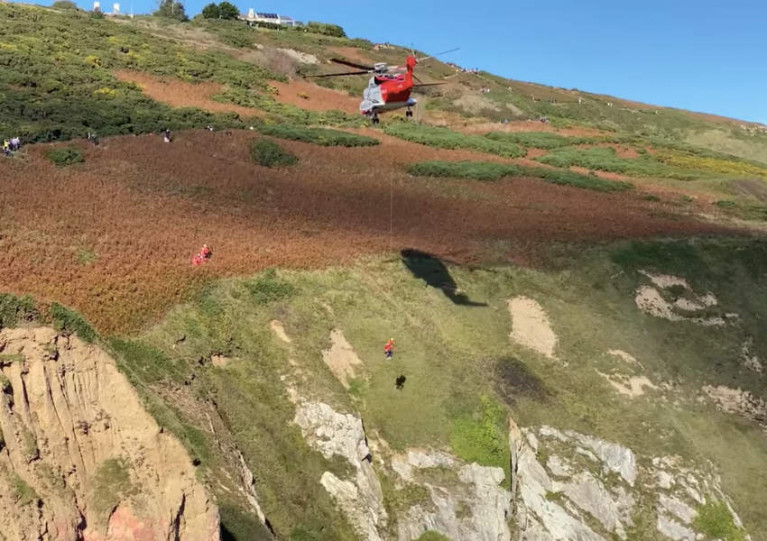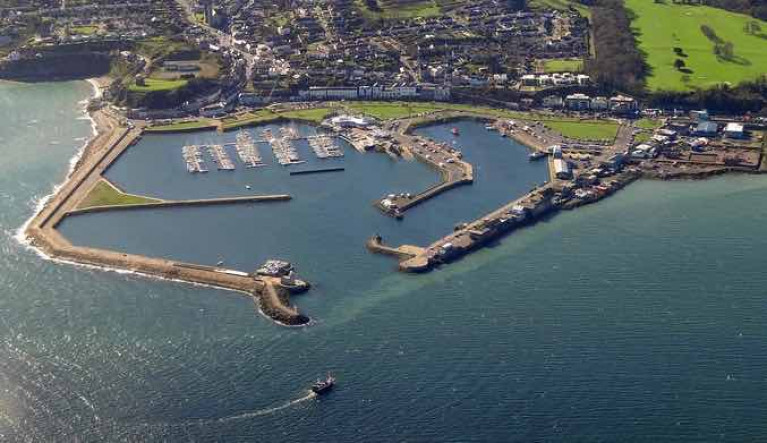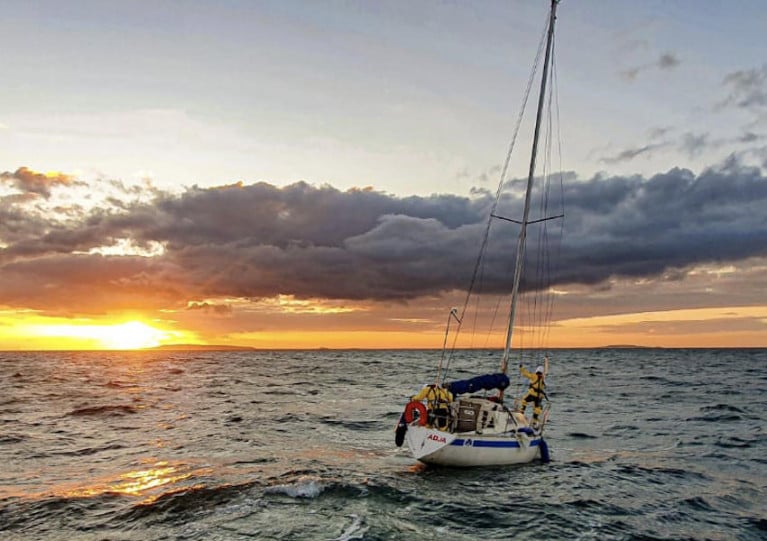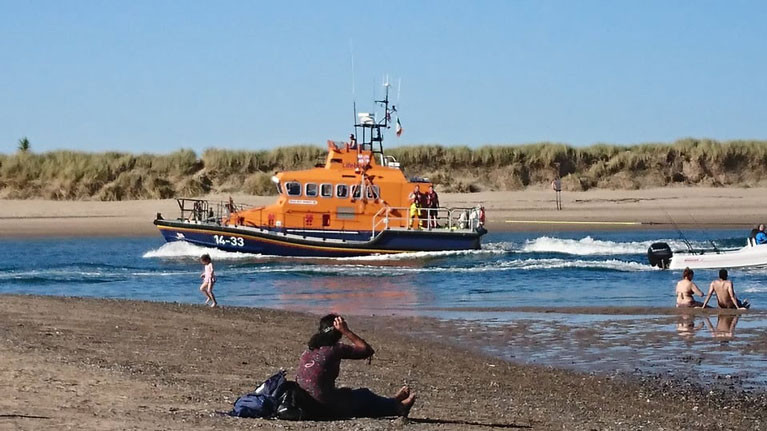Displaying items by tag: Howth
Howth RNLI was on exercise this afternoon Saturday 24th April when it received a call to join the Irish Coast Guard Helicopter Rescue 116 who were tasked to locate a kite-surfer who had got into difficulty off Sutton Strand in North Dublin.
The wind had reduced in strength which caused the kite equipment that the kite-surfer was using to collapse into the water and he was unable to launch the kite again and was drifting towards Sutton estuary.
The Coast Guard Helicopter was already on scene and dropped a smoke marker to aid the Howth RNLI Lifeboat locating the casualty.
The kite-surfer was taken aboard the inshore lifeboat and safely returned to shore.
The volunteer lifeboat crew were Ian Martin (Helm), Lorcan Dignam and Ronan Murphy.
Speaking following the callout, Ian Martin, Howth RNLI Inshore Lifeboat Helm said: ‘Our volunteer lifeboat crew are always ready to respond to a call for help and we train for situations just like this. We were delighted to be able to quickly locate the kite-surfer with the assistance of Rescue 116 and bring him back to safety’’.
TheJournal.ie reports that a man in his 20s has died after getting into difficulty while swimming in the sea off Howth yesterday afternoon, Friday 2 April.
Howth Coast Guard Rescue and Howth RNLI were tasked to the scene at the so-called Hidden Beach by Whitewater Brook, near the Baily Lighthouse, as part of a multi-agency response.
The Irish Coast Guard’s Dublin-based helicopter Rescue 116 also responded and its crew winched the casualty aboard for transfer to a waiting ambulance.
It is understood the young man was pronounced dead at Beaumont Hospital some time later.
The tragedy comes just days after the RNLI and Irish Coast Guard issued a joint appeal to the public to heed safety advice when on or near the water over the Easter weekend and beyond, as previously reported on Afloat.ie.
Jacko the Dog Lifted to Safety by Howth Coast Guard After Cliff Fall
Howth Coast Guard’s cliff rescue team came to the aid of relieved owners after Jacko the dog fell over a cliff on Howth Head yesterday afternoon, Friday 26 February.
It emerged that Jacko had been distracted by wildlife while out for a walk on the cliff path, and had slipped 100 feet down the steep cliff face to the rocks below.
Shortly after 1pm, Howth’s Irish Coast Guard unit dispatched a team of 12 to the scene near Casana Rock, where they set up their ropes and lowered a rescue climber with a dog harness over the cliff edge.
Shortly after, Jacko had been lifted to safety and reunited with his owners, who swiftly brought him to the vet for treatment for injuries he sustained in his fall.
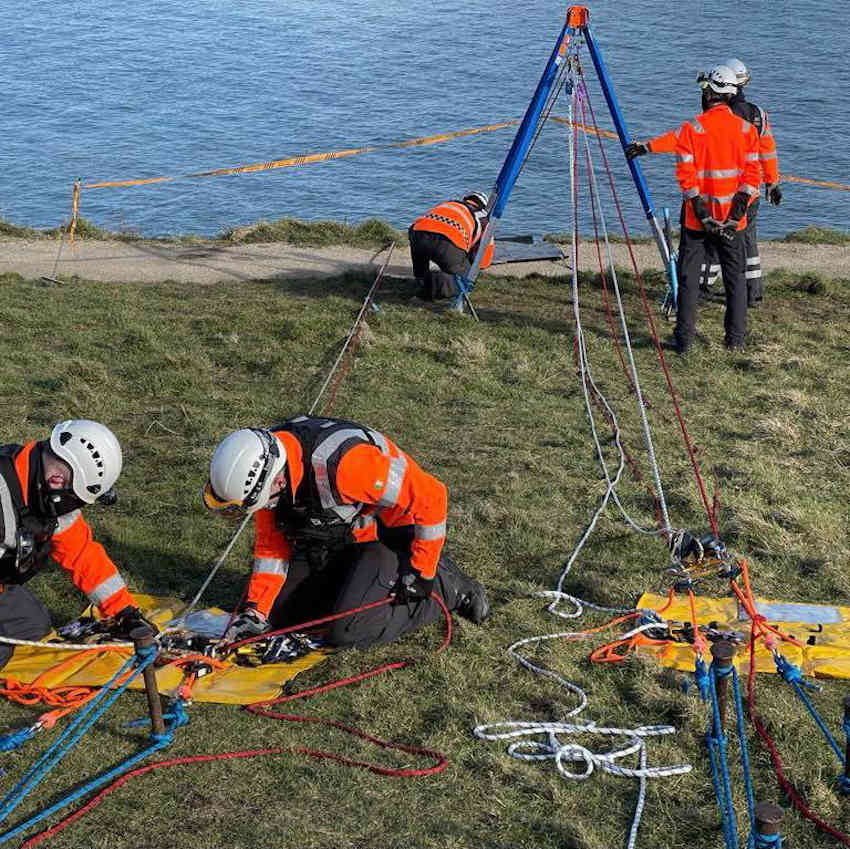
“We are appreciative that the owners remained on the path and called for help immediately,” Howth Coast Guard said.
The unit added that its members attend over 100 calls a year, and with travel limitations in place this year is expected to be as busy if not busier than previous.
All are encouraged to call for the coastguard at 112 or 999 if they see someone who may be in trouble on the cliffs, beach or water.
Howth RNLI Rescue Fishing Boat with Mechanical Problems
Howth RNLI launched the all-weather lifeboat to rescue a 21-foot fishing boat with two people onboard after it suffered mechanical failure just off Rush Co. Dublin
The RNLI pagers sounded at 2.52 pm on Monday 18th January to reports of a small fishing boat with 2 people aboard with mechanical problems. The all-weather lifeboat was launched and travelled to the stricken vessel which had managed to drop an anchor 400 metres off the coastline of Rush in North Dublin.
The volunteer lifeboat crew promptly took the vessel in tow and returned the 21-foot boat along with its two occupants back to its homeport of Malahide marina.
The Howth Lifeboat and volunteer crew returned to Howth station and stood down at 4.35 pm.
Speaking following the callout, Colm Newport, Howth RNLI Lifeboat Operations Manager said: ‘Our volunteer lifeboat crew were pleased to be able to quickly respond and tow the small fishing boat to the safety of Malahide Marina'.
Howth RNLI Rescue Fishing Trawler & Crew After Running Aground
Howth RNLI launched the all-weather lifeboat to rescue a fishing trawler, six people, onboard after it ran aground on rocks in Balscadden Bay, at Howth in County Dublin.
The RNLI pagers sounded at 4.12 pm on Thursday 7th January to reports of a fishing trawler aground just outside Howth Harbour in Balscadden Bay. The all-weather lifeboat was launched and was on the scene in a matter of minutes.
The trawler was hard around and listing to one side. The lifeboat crew assessed the fishing trawler and deemed it safe to put a tow line aboard. Fred Connolly, Howth RNLI Lifeboat Coxswain carefully navigated the all-weather lifeboat in the shallow water and the volunteer crew got a tow line aboard the stricken trawler.
 The tide was rising and the lifeboat eased the trawler off the rocks and into deeper water
The tide was rising and the lifeboat eased the trawler off the rocks and into deeper water
The tide was rising and the lifeboat eased the trawler off the rocks and into deeper water. The trawler was brought back to the safety of Howth Harbour.
The Howth Lifeboat and volunteer crew returned to Howth station and stood down at 5.50 pm.
 The fishing trawler aground in Balscadden Bay Photo: Annraoi Blaney
The fishing trawler aground in Balscadden Bay Photo: Annraoi Blaney
Speaking following the callout, Ian Malcolm, Howth RNLI Deputy Launching Authority said: ‘Our volunteer lifeboat crew were pleased to be able to quickly respond and tow the fishing vessel to the safety of Howth Harbour. Our Lifeboat volunteers train regularly to prepare for situations just like this’’
The crew on the Howth RNLI Trent Class All Weather lifeboat were; Fred Connolly - Coxswain, Ian Sheridan - Mechanic, Killian O’Reilly, Ian Martin, Aidan Murphy, Stephan Mullaney and Ronan Murphy.
Howth RNLI 'Dip & Donate' Appeal is Launched
Instead of Christmas swims, Howth RNLI fundraisers in County Dublin are asking Howth peninsula swimmers to "DIP & DONATE" to the RNLI anytime between December 19th and Jan 7th.
Howth RNLI has posters with a printed QR code (see above) for scanning by camera phone to take swimmers directly to the RNLI Justgiving page, Howth RNLI's Rose Michael told Afloat.
Mass Christmas sea swims, often held in aid of charities, such as the RNLI, have been discouraged this year due to pandemic measures to kerb social gatherings.
Howth Lifeboat Station continues to rely on voluntary contributions and legacies for income. It is only through thoughtful gifts and donations that the RNLI is able to provide our volunteer lifeboat crews with the boats, facilities, equipment and training that are essential to save lives at sea.
Since 1825 an all-weather lifeboat has launched into Dublin Bay from Howth and the crews have been honoured with 20 awards for gallantry.
Today the station operates both a Trent class lifeboat and an inshore D class lifeboat.
Two Rescued From Cliff Face Near Howth’s Baily Lighthouse
Two people — one with an injured ankle — were rescued by the Irish Coast Guard after getting stuck on a cliff near the Baily Lighthouse on Howth Head yesterday afternoon (Sunday 11 October).
Howth Coast Guard’s cliff team reached the scene just as the Dublin-based helicopter Rescue 116 arrived, and it was decided the helicopter crew would recover the casualties to the cliff top.
The winchman was lowered with a double hoist lift both casualties, which TheJournal.ie reports were an adult and a teenager, to the top and into the care of the cliff team.
The younger of the pair had sustained an ankle injury that was not thought to be serious, but as a precaution they were stretched to the nearest road to meet an ambulance crew fro transfer to hospital.
“This was a lucky escape for the two casualties,” said a coastguard spokesperson.
“Due to the quick response by the public in calling 999 and giving an accurate location of the incident, rescue teams were able to quickly deploy.”
Howth Harbour Gets Sisk the Builders In
"Getting the builders in" is a challenging prospect on land at the best of times. Add in the sea, and it's then a challenge-plus. Thus when you're working on and in the waterfront to implement a project within a busy fishing/sailing harbour which has found itself becoming something of a cult tourism magnet, the problems are magnified tenfold for contractors and harbour users alike.
Certainly, this is the prospect at Howth, where this week Sisk the Builders will be starting to move in to set up a new operational site on the Middle Pier. This will – in just 13 months, it is hoped - provide a completely new 135 metres of proper quay wall along the currently rock-armoured west side of the Middle Pier, with dredged material from the new "long berth" being deposited in a revetment-retained infill on the Middle Pier's East Side, thereby providing much-needed extra shore space for vehicles serving the boats using the new berths.
Part of Howth's attraction for visitors is the colourful but often very crowded scene along the main fishing boat area on the West Pier. It's entertaining to be feasting off seafood at one of the many characterful restaurants along the pier, as forklifts with fishing gear go buzzing closely past. And every so often, a seemingly enormous fishing boat makes her stately way across the quay in slow style on the Syncrolift trolleys to receive the attentions of Johnny Leonard and his skilled staff in the shipyard. There's never a dull moment. But there are times when it's all just too much of a good thing. A safety valve of alternative berthing and extra shoreside space was becoming urgently needed.
 Howth's Fish Dock may provide a colourful setting for a quayside array of characterful seafood restaurants along the West Pier, but extra berthing space is urgently needed. Photo: W M Nixon
Howth's Fish Dock may provide a colourful setting for a quayside array of characterful seafood restaurants along the West Pier, but extra berthing space is urgently needed. Photo: W M Nixon
Down along the west side of the Middle Pier was the only option. This would be simple enough if everyone was game to close off substantial parts of the harbour to let the contractors have a free run at the job. But it says everything about the spirit of Howth that this doesn't seem to have occurred to anyone. From the beginning, the assumption was that virtually all of the harbour's activities could continue with as little interruption as possible, and Harbour Master Harry McLoughlin and Howth Yacht Cub Commodore Ian Byrne, together with representatives of other interests, set themselves the task of facilitating the contractors while keeping the floating show on the road.
As Ian Byrne became our "Sailor of the Month" back in May for deciphering the multiple rules for exiting the first Covid lockdown in a way which was comprehensible to all sailors, he was ideal to speak for the consumers, while Harry McLoughlin - a widely-experienced harbour master who has a real vision for Howth - ably filled the role as the human face of officialdom. Between themselves and the contractors, they worked out a viable scheme despite having to include extra elements made necessary by the space requirements of COVID-19
 Site plan showing (red line) the agreed limits of the boundary of the works. This will enable much of the harbour – including the public slipway beside the Lifeboat Station – to continue to function, but inevitably there will be some reduction in car parking spaces.
Site plan showing (red line) the agreed limits of the boundary of the works. This will enable much of the harbour – including the public slipway beside the Lifeboat Station – to continue to function, but inevitably there will be some reduction in car parking spaces.
Of course, those who know Howth well appreciate that while this new project will – if all goes according to plan - give the fishing fleet a very welcome and useful Christmas present at the end of 2021, it is just the beginning of a process in which the long-overdue dredging of the harbour – more needed in some parts then in others – is steadily moving up the agenda.
But if this scheme goes according to plan in a spirit of harmony, it will, in turn, create the atmosphere in which other mutually beneficial works can be undertaken with an attitude of realism and a mood of mutual respect. And if by some happy chance the pandemic subsides and visitors are allowed back to Howth in their previous numbers next Spring, well, the fact that there's an interesting bit of maritime contracting work underway will give them something extra to look at, for the main attraction of Howth Harbour seems to be that people on holiday enjoy nothing more than watching other people doing unusual work…
 By the beginning of November (COVID permitting) this end section of Howth's Middle Pier will be a hive of activity with the rock armour on the Fish Dockside being converted into a quay wall.
By the beginning of November (COVID permitting) this end section of Howth's Middle Pier will be a hive of activity with the rock armour on the Fish Dockside being converted into a quay wall.
Howth Lifeboat Rescues Lone Yachtsman Stranded In Irish Sea
Howth RNLI launched to the rescue of a solo sailor whose yacht got into difficulty in the Irish Sea off Dublin yesterday evening, Thursday 3 September.
Pagers sounded at 7.10pm and the all-weather lifeboat was launched, its crew locating the stricken yacht some five miles east of the Kish Lighthouse.
The vessel had suffered rigging and engine damage and was unable to make way so the lifeboat crew took it under tow to the safety of Poolbeg Marina, where it was tied up at 10.45pm.
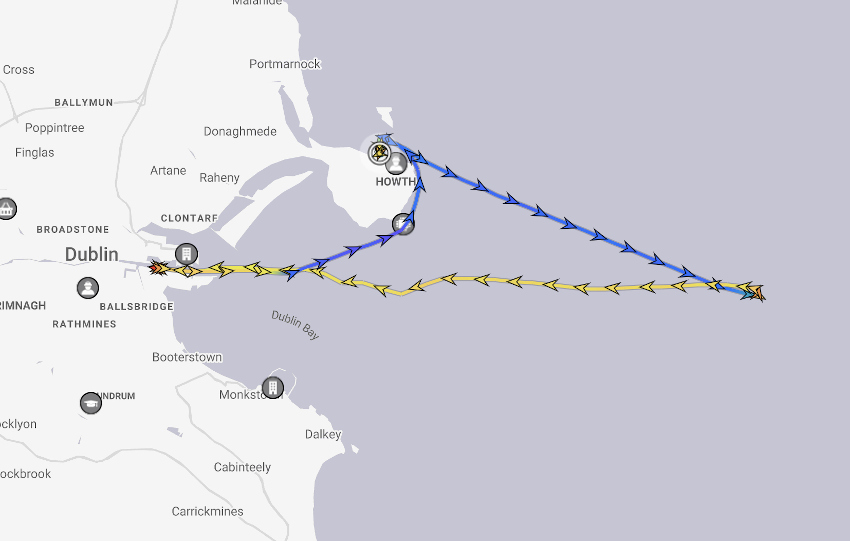
Howth RNLI reported that the lone yachtsman was in good spirits despite his ordeal.
Speaking after the callout, lifeboat coxswain Fred Connolly said: “Our volunteer lifeboat crew are always ready to respond to a call for help and we train for situations just like this.
“We were delighted to able to quickly locate the sailing boat, commence the tow and bring the sailor safely back to Dublin Port.”
Howth RNLI launched both the all-weather lifeboat and the inshore lifeboat in two separate callouts over the weekend to rescue eight people who found themselves in difficulty. One callout saw a teenager’s life saved when the lifeboat crew found him clinging to a buoy in the middle of the estuary.
The RNLI pagers sounded at 1.35 pm on Friday (7 August) after a call was placed to the Coast Guard reporting two people in difficulty swimming at Cush Point in Baldoyle estuary. The inshore lifeboat was launched and located the two people 11 minutes later as they made their way back to shore. Colin Murray from Howth Coast Guard spoke to the two boys and it emerged that there was a third person still missing. The lifeboat crew quickly established a search pattern and located the casualty clinging to a buoy in the middle of the estuary. He had been there for nearly 30 minutes and was exhausted. The casualty was taken aboard the lifeboat, assessed and treated before bringing back to the lifeboat station.
The lifeboat crew were called into action again the following afternoon (Saturday 8 August) at 4.50 pm to reports of a speed boat that had mechanical problems just north of Lambay Island. The all-weather lifeboat was launched and quickly located the boat with four family members onboard. The speedboat was taken in tow by the volunteer crew of the all-weather lifeboat and the family were unharmed by the incident and returned safely to Malahide Marina.
Speaking following the callout which saw the teenager rescued, Fin Goggin, Howth RNLI Helm said: ‘What we thought was a callout to two swimmers who had made their way back to shore quickly turned into a search for a missing teenager. When we found him a short time later clinging to the buoy, very tired but alive, we realised it could have had a very tragic outcome.


























